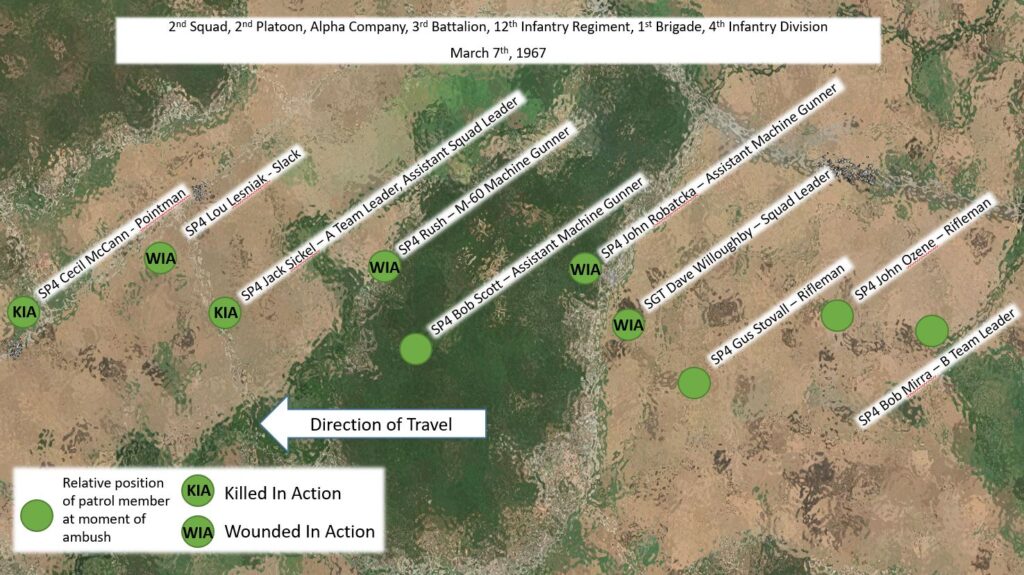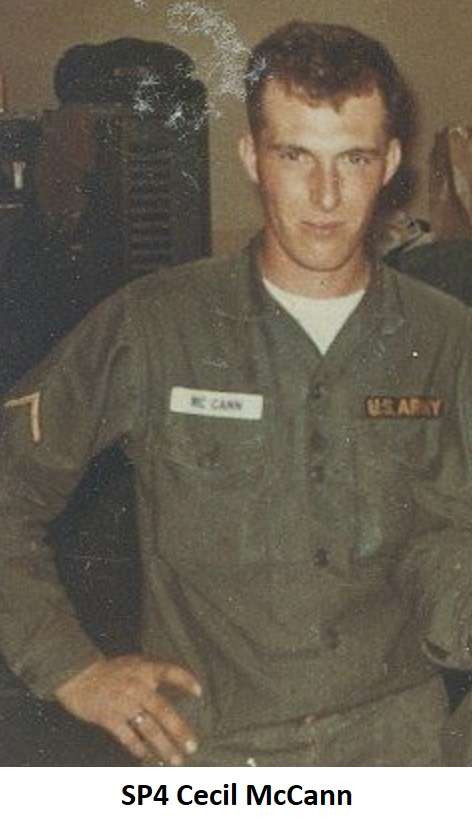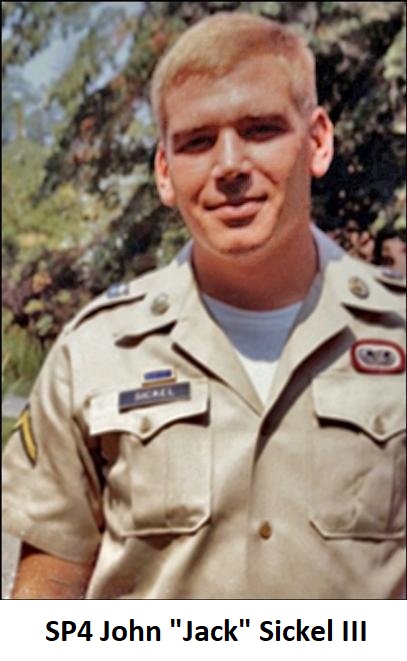1967 – MARCH
From September of 1966 to February of 1967, the Braves of the 3-12 had become acclimated to this new style of guerrilla warfare. Hard lessons had been learned. The M-113 incident in February caused a stand down at the 10th Cav, and all drivers and commanders received retraining on the proper use of the trim vanes. Losing men in combat was inevitable, but losing them in such a preventable accident was a tremendous blow to morale. There were victories too. On March 1st, elements of the 3-12, working in conjunction with A-1/10 Cav, killed fourteen Viet Cong while suffering no friendly casualties. The core group of original A/3-12 men were seasoned, and knew what it took to survive the endless patrols in the jungles around Tuy Hoa. But sometimes in war, a unit will learn a lesson the hard way, and in time, that lesson goes forgotten, setting up a new unit to learn it the hard way all over again.

Hill 86 lies in the middle of a small valley in northern Phu Yen Province that runs generally northeast-southwest. Located about four kilometers west of the intersection of Route QL1 and the old Route 6B, which is now route DT543, the hill is bordered on its western side by a large stream that flows north from a large lake 20 kilometers to the south to the mighty Ky Lo River. A smaller tributary reaches around the eastern side of the hill, but isn’t much more than a ditch at some points. The hill itself stretches about one kilometer in length in total. It rises gradually from its north-eastern tip touching the old Route 6B to it’s peak at 86 meters, which is located about three quarters of the way down it’s length. The backside of the hill falls off more steeply, and levels off into the surrounding rice paddies and low land fields. To the east rises the 308 meter peak of Nui Ba, while the west is bordered by a roughly 10 kilometer by 8 kilometer mass of jungle hills, with the peak being nearly centered at 382 meters. The south side of the hill consists of marshy rice paddies and lowland irrigation ditches and streams for nearly two kilometers before the terrain rises up into another mass of jungle hills.
In September of 1966, as the advanced party of the 3-12 Infantry first set foot in Vietnam, Company B, 2nd Battalion, 327 Infantry established its command post on top of Hill 86. B-2/327 was an experienced unit in the 101st Airborne Division that had earned a Presidential Unit Citation for its role in the battle of Trung Luong in Operation Nathan Hale just a few months earlier. Now, stationed closer to Tuy Hoa, B-2/327 had maintained its command post on Hill 86 for several weeks, in order to draw out the shadowy NVA and VC units that were known to be active in the area.
On the night of September 17th, in a driving rainstorm, the NVA and VC units launched a massive attack on Hill 86. Knocking out the communication array at the top of the hill and most of the command group with one of the first salvos, the enemy then swept the hill, using small arms, grenades and satchel charges to kill and wound any American they could find. Only through the gallant efforts of individual Soldiers were the Americans able to hold off the enemy long enough for the dispersed platoons of Bravo company to come to the aid of their headquarters element. By the end of the battle, ten Americans were dead and fifteen wounded. Never again would the battalion allow a company command post to remain in one fixed location for more than 48 hours.
In reality, the lesson that should have been learned was that Hill 86 was far too vulnerable to serve as a command post, or even a night defensive position for that matter. The local VC had every inch of it mapped and plotted for mortar fire, including the foxholes, bunkers and trails that the American units had developed. Surrounded on two sides by hills of higher elevation, it was constantly under enemy surveillance from the heights, or from the numerous villages that spread throughout the rice paddies on all sides. This lesson may have been learned the hard way by the men of the 101st Airborne, but it wasn’t passed on to other American units in the area, or if it was, it was soundly ignored.
In March of 1967, it was A/3-12s turn to occupy Hill 86. The 2nd Platoon was ordered to occupy the Hill and patrol the surrounding areas, while the other platoons of Alpha built NDPs in the nearby hills. The units would fan out from their patrol bases during the day, searching the surrounding villages and making their presence known. They knew the Viet Cong and their NVA counterparts were out there, and were looking for a fight.

On the afternoon of March 7th, 2nd Squad of 2nd Platoon was the lead squad for the platoon moving through a series of rice paddies within sight of Hill 86. Led by Sergeant Dave Willoughby, most of the men of 2nd Squad had been together since Ft. Lewis. They were veterans now, but had been lucky in the six months they had been in the country, and had only seen limited action and few casualties.
The squad moved out with the Alpha fire team in the lead, and Cecil McCann in his usual position as pointman, then Lou Lesniak in slack position than the Alpha Team Leader, Jack “The Shark” Sickel, who was also the assistant squad leader. Next in the order of march came the machine gunner Rush and his M60 team of Bob ‘Scotty’ Scott and John “Garbage Man” Robatcka. They were followed by Squad Leader Dave Willoughby, who in turn was followed by the Bravo fireteam, which consisted of Gus Stovall, John Ozene and Bob Mirra, who was the Bravo Team Leader and rear security for this patrol.
While crossing a paddy, a hidden enemy unit opened up with automatic weapons fire. The first three men in the column dropped immediately. Multiple bullets struck the point man, Cecil McCann, and he was dead before he hit the rice paddy. Jack Sickel, standing totally exposed in the middle of the paddy, was hit and slumped to the ground. Lesniak dropped to the ground as well, hit in the back and now totally exposed, yet still alive. He would remain motionless in that position for the duration of the fight.
In the middle of the column, machine gunner Rush and assistant gunner Robatcka were both hit multiple times. As squad leader Dave Willoughby yelled back at Mirra to get the M60 working, he too was hit, taking him out of the fight. Gus Stovall and Bob Mirra moved up to the M60 while under fire but couldn’t get it unjammed and into the fight. In less than a minute, six of the ten men in the patrol were down and out of the fight. The remaining four men were pinned down under a constant barrage of automatic weapons fire.
The rest of the 2nd platoon, including the Platoon Leader, 1LT Carpenter, was out of sight and out of PRC 6 range, so survivors were on their own. Mirra offered to stay behind to offer cover fire for the men in front that were pinned down. Rush was incapacitated and couldn’t be moved. The wounded squad leader Willoughby, Ozene and Scott grabbed Robatcka and headed away from the kill zone. Gus Stovall stayed with Mirra, his team leader. Time passed by, and Gus and Mirra pressed themselves into the paddy, the enemy fire continuing to come in, heavy and low. Gus covered 180 degrees to the front, while Mirra faced the opposite way, covering the opposite 180. The groaning Rush laid between them.
Once the fire subsided, Mirra crawled up to check on the men in front. Jack Sickel was squatting in a small depression, a small trickle of blood coming from an exit wound in the back of his skull. Mirra hoped it had been quick. Jack and Rush had been close, so Mirra kept it to himself, no need to upset the already wounded machine gunner.
Mirra waited a while, then he and Gus moved forward again to check on McCann and Lesniak. He heard chatter in Vietnamese, and hoped it was just locals from the hootches to their front. He crawled to the edge of the banana grove and immediately saw three VC, hatless and wearing khakis, one cradling a .45 caliber Thompson submachine gun, the other two with carbines. Mirra turned slightly to Gus and signaled his intentions, then stood up, flipped to automatic and sprayed them with 5.56 rounds from his M-16. The one with the Thompson was hit at least twice. Mirra and Gus dropped back down and scurried back to Rush. The VC disappeared into the brush. Gus gently picked up Rush, Mirra grabbed the extra weapons and they moved into the open back of the grove.
Four Huey gunships had been called in and started circling the area. Mirra looked up and saw the rest of Alpha Company moving down a dike towards them, his friend Joe Santini frantically waving to make sure Mirra didn’t confuse them with the enemy.
John “Jack” Sickel of Longmeadow, Massachusetts was the twin brother of Jeffery Sickel, and 22 years old when he was killed. Cecil Darrell McCann of Melvindale, Michigan was 21 years old, and his death made a widow out of his young wife, and robbed his young daughter Renee of a childhood with her father.
Later, back on Hill 86, 1LT Carpenter erupted at Mirra, and berated him for firing full automatic and not killing all three VC. But Mirra didn’t feel like arguing back. At that moment, he was just trying to convince the VC that he was more than just one scared 19 year old standing in their way. The 2nd squad was now just three men. The squad leader Mirra, with Gus and Ozene. To replace their losses, the Alpha Company Commander, CPT Conners, requested emergency replacements from battalion headquarters. Several men from the radar section in Headquarters Company were sent to Alpha. The men from HHC showed up at Hill 86 without any ammo, completely unprepared for what was about to be thrown at them.
To be continued…..


